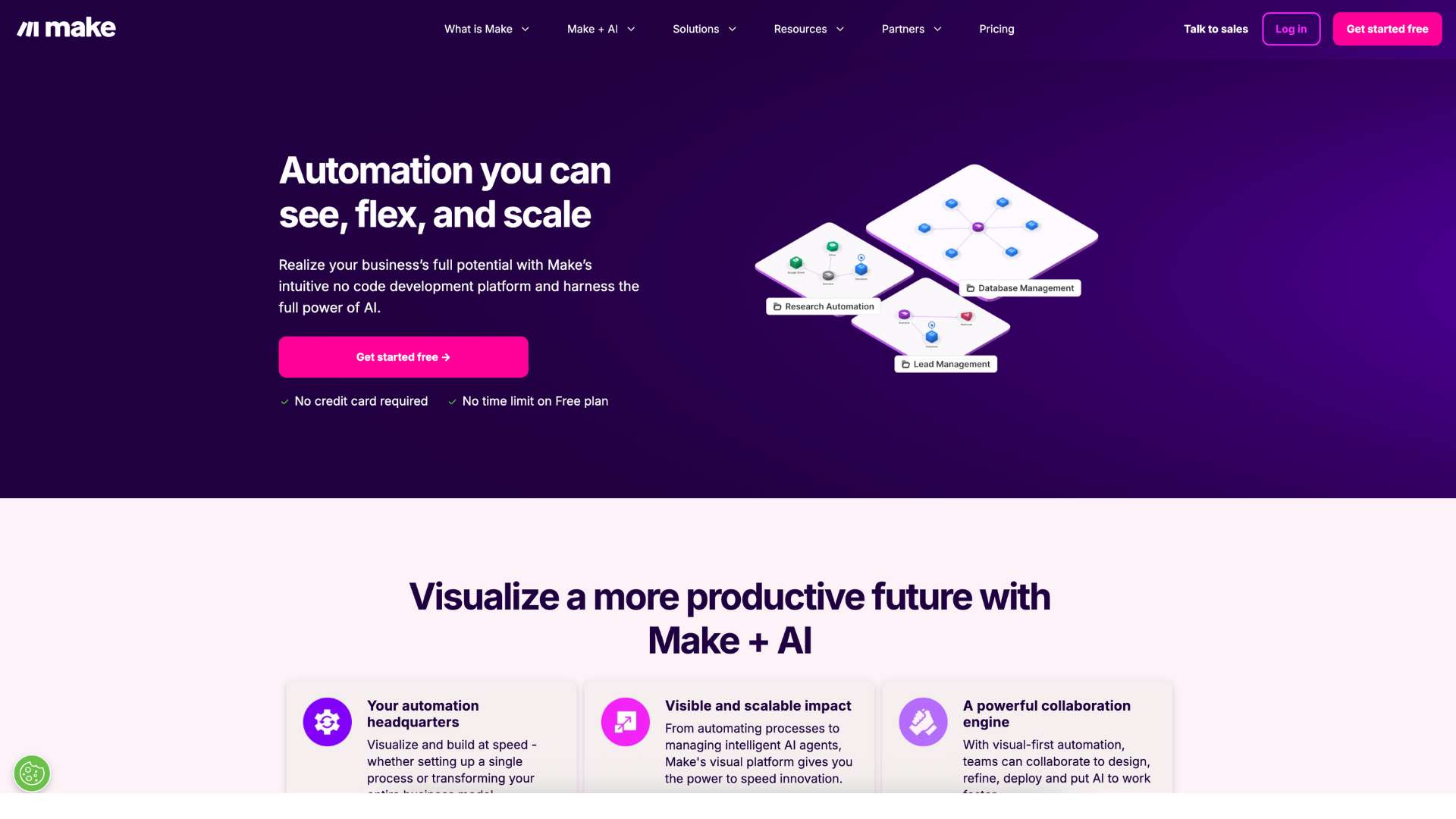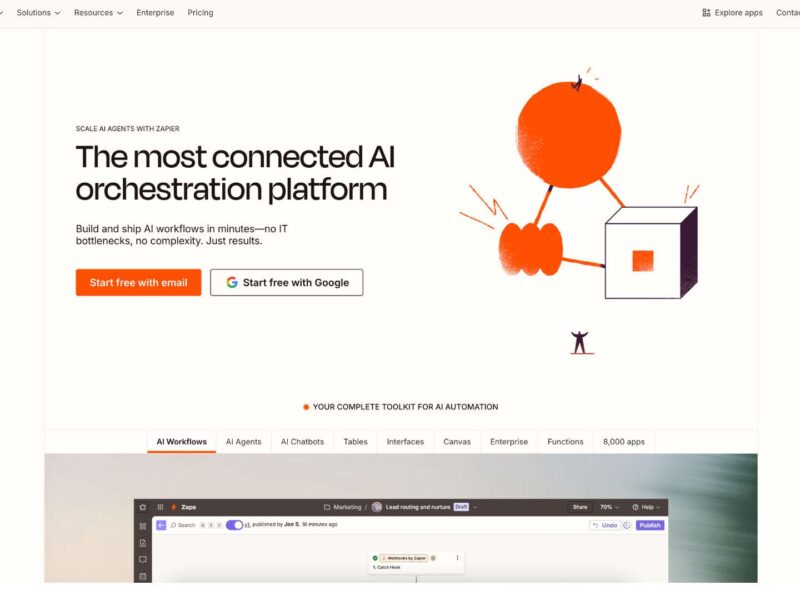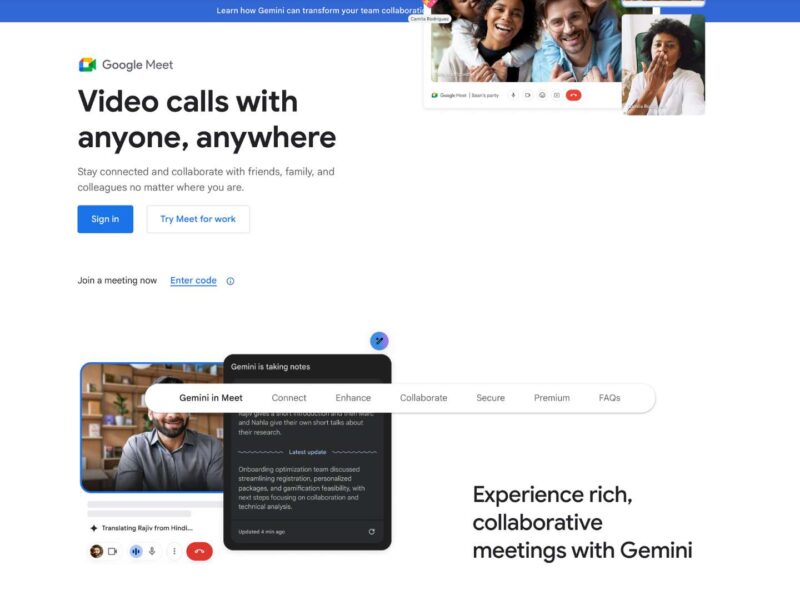Make.com Review – Features, Pricing, Pros & Cons
Make.com, formerly known as Integromat, is a visual automation and integration platform designed to help users connect their favorite apps, automate business tasks, and eliminate repetitive work.
By offering a drag‑and‑drop scenario builder, conditional logic, and thousands of integrations, Make.com empowers users to convert manual processes into powerful, scalable workflows.
Automation remains a core challenge for many businesses—tool silos, manual data transfers, and unmonitored actions can slow operations and introduce errors. Make.com addresses this by offering a central dashboard where users can build integrations visually, monitor execution, and handle exceptions gracefully.
Ideal users include freelancers, marketers, operations teams, IT departments, agencies, and small-to-medium businesses. Whether it’s syncing CRM entries with email campaigns or triggering notifications on Slack based on form responses, Make.com provides the flexibility and power to automate complex sequences without requiring deep programming skills.
Company Background
Make.com was founded in 2012 as Integromat. It originated in Prague, Czech Republic, under co-founders including Ondřej Gazda, with the mission to simplify automation for non-developers through a visual, flow-based interface.
By 2021, Integromat had amassed millions of users globally, thanks to its vast integration library and robust scenario-building capabilities.
In April 2022, Integromat rebranded to Make.com following its acquisition by Celonis, a leader in process mining. This move expanded Make’s reach and reinforced its platform as a full-stack automation tool. The visual metaphor of making and building complex systems aligned well with the “Make” branding.
Headquartered in Prague, Make.com continues to innovate under Celonis, enhancing both the platform’s core and introducing AI-led automation tools and enterprise-grade features.
Key Features
Visual Automation Builder
- Drag‑and‑drop canvas for scenario building
- Unlimited steps, routers, filters, and logic gates
- Interactive data maps for flow-debugging
App Integrations
- Over 1,500 app integrations including Google Workspace, Slack, Shopify, Airtable, Notion, Discord
- HTTP and Webhook modules for bespoke API integrations
Real-Time Execution & Scheduling
- Immediate and scheduled triggers
- Detailed logs and execution histories
- Error handling with breakpoints and notifications
AI & Advanced Functions
- Integration with AI services such as OpenAI/ChatGPT
- Support for JavaScript modules, regex, and text parsing
- Transform, filter, and enrich data within flows
Collaboration & Permissions
- Shared folders, teams, and assets
- Custom roles: Admin, Scenario Creator, Read‑Only
- Activity logging and audit trails
Versioning & Scenario Management
- Version control built into scenario editor
- Switch between versions and roll back changes
Error Handling & Monitoring
- Automated retry logic on failure
- Visual breakpoints and conditional paths
- Centralized execution dashboard with logs
Templates & Community Assets
- Extensive template library
- Official and community-uploaded workflows
- Clone, modify, and deploy with one click
User Interface and Experience (UI/UX)
Make.com’s web interface is modern and user-friendly, presenting scenarios as colorful flowcharts with labeled modules and connectors. The design encourages readability and organization—even complex automation sequences feel manageable.
Onboarding offers interactive scenario templates to guide new users. Tooltips, inline documentation, and a responsive help panel reduce the learning curve. Despite its power, Make.com can feel dense at first—particularly for those unfamiliar with conditional logic or API concepts.
Mobile access is browser-based, without dedicated iOS or Android apps. This means scenario creation is best done on desktop, but system monitoring or quick fixes remain accessible remotely.
While keyboard navigation and alt-text support are present, there’s no official accessibility certification. The product feels optimized for visual clarity and workflow-oriented users.
Platforms Supported
Make.com is delivered entirely via web. Here’s a breakdown:
| Platform | Supported |
|---|---|
| Web Browser | ✅ |
| Windows/macOS/Linux | ❌ No native desktop app |
| iOS/Android | ❌ No mobile app |
| Cloud-hosted | ✅ Full cloud deployment |
| Local/offline access | ❌ Not available |
This cloud-first design ensures scalability, high availability, and remote access, ideal for distributed teams and freelancers who work across devices.
Pricing
Make.com offers several tiered plans based on monthly operations and features:
| Plan | Price (Monthly) | Monthly Operations | Active Scenarios | Support Levels | Best For |
|---|---|---|---|---|---|
| Free | $0 | 1,000 | 2 | Community support only | Solo users, simple projects |
| Core | $9 | 10,000 | Unlimited | Email support | Freelancers, startups |
| Pro | $16 | 40,000 | Unlimited | Email + webchat (est.) | Power users |
| Teams | $29 | 150,000 | Unlimited | Priority email, team tools | SMEs, teams |
| Enterprise | Custom | Unlimited | Unlimited | SLA, dedicated support | Large orgs, advanced needs |
All plans offer a 7-day free trial of higher tiers. Pricing scales based on operational usage—optimization is key to avoid unnecessary cost spikes.
Pros and Cons
Pros
- Powerful visual interface: Enables creation of complex workflows with conditional logic.
- Rich integrations: Extensive library plus HTTP/Webhook modules for custom apps.
- Advanced functions: Regular expressions, JavaScript, AI integrations.
- Team tools & versioning: Built-in collaboration, roles, and rollback features.
- Transparent, scalable pricing: Plans vary with user needs and growth.
Cons
- Learning curve: Beginners need time to learn builder conventions and best practices.
- No native mobile app: Managing flows on the go can be unwieldy via a browser.
- Potential cost overruns: Inefficient scenario design can use operations fast.
- Complex debugging: Large, nested scenarios may be difficult to troubleshoot visually.
Customer Support and Resources
Support depends on plan level:
- Free/Core: Email and community forum
- Pro/Teams: Email + estimated webchat (higher tiers get faster responses)
- Enterprise: SLA‑backed email, phone, and dedicated success manager
Make.com boasts a rich Help Center with guides on building popular scenarios, using the API, and implementing best practices. Tutorial videos, blog posts, and live webinars reinforce usage skills.
A global community, via forum and Reddit, shares templates, tips, and scenario examples. This ecosystem enhances learning and problem-solving beyond official documentation.
Real‑World Use Cases / Ideal Users
Marketing Agencies
Automate lead ingestion, enrich data from sources like Gravity Forms, send to CRM, and notify via Slack—saving hours weekly and reducing data errors.
eCommerce Sellers
Sync Shopify inventory and order info to Google Sheets or Airtable, trigger external API calls for shipment tracking or payment alerts.
SaaS Onboarding Teams
Use Make.com to handle user onboarding flows—pull details from signup forms, create Airtable records, and send welcome emails.
Freelancers & Consultants
Auto-generate invoices based on form submissions, update client databases from task tools, or assemble weekly analytics into reporting docs.
Operations Teams
IBM: cross-database synchronization, automated updates between legacy systems and new cloud apps, plus real-time error notification through Slack or email.
Enterprise & IT Departments
Use advanced API modules and webhooks to integrate with internal systems, apply governance policies, and enable secure data orchestration at scale.
User Reviews and Ratings
Make.com receives strong feedback across review platforms:
- G2: 4.7/5
- Capterra: 4.8/5
- Trustpilot: 4.5/5
Sample user quotes:
“Make is like LEGO for automation. You can build anything if you know what you’re doing.” – Nathan M., G2
Users consistently compliment its flexibility, visual clarity, and cost-effectiveness. Concerns occasionally mention the learning curve, but most highlight that the adjustable plan pricing makes it an accessible powerhouse.
Best Alternatives
| Alternative | Best For | How It Compares |
|---|---|---|
| Zapier | Simpler automations for beginners | Easier to learn; limited logic and operation control |
| Pabbly Connect | Budget-conscious users | Lower cost; fewer integrations than Make.com |
| Tray.io | Enterprises needing advanced automations | More powerful; more expensive and developer-focused |
| n8n | Open-source, self-hosted stack | Full customization; needs technical setup |
| Workato | Complex corporate integrations | Better for big enterprises; premium pricing |
Make.com shines for visual power users. For simpler needs, Zapier’s ease or Pabbly’s low cost may win. If open-source control is needed, n8n is a strong option.
Summary
Make.com sets a high standard among no-code automation platforms. Its flexible, visual scenario builder paired with advanced logic, AI features, and deep integrations creates opportunities to streamline workflows across agencies, operations teams, freelancers, and enterprises.
While there’s a learning curve and mobile management is browser-bound, the platform’s payoff—in time saved and operational efficiency—makes it a wise choice for users ready to build serious automations.
Ideal users include process-heavy teams, tech-savvy individuals, and automation-first businesses. If simplicity is paramount, start with Zapier or Pabbly. For open-source needs, n8n is noteworthy.
Ready to automate? Start your Make.com journey, explore comparisons at usefully.site, and build workflows that make a difference.
Media
Master Make.com in 2 Hours: Complete Beginner’s Guide for 2025
Make.com Automation Tutorial for Beginners
Make.com Tutorial 2025: How to Use Make.com (Step by Step)


